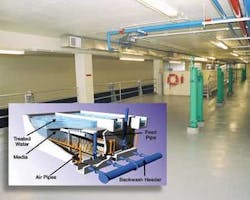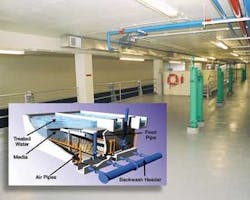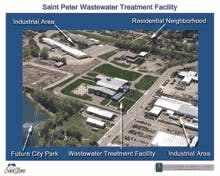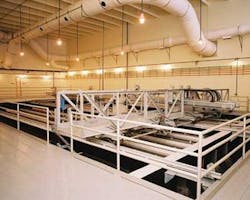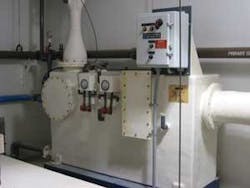by Jeff Knutson, Jon Peterson and Tom Miles
Since the Saint Peter wastewater treatment plant (WWTP) became operational in February 2004, various Minnesota associations and agencies have recognized its environmental and engineering efforts. The four-time award-winning WWTP discharges minimal phosphorus into the Minnesota River, generates Class A-EQ biosolids (with low metals content), and significantly reduces odors produced during wastewater and biosolids treatment processes.
Located in the Minnesota River floodplain, Saint Peter’s former 202-acre stabilization pond treatment system was one of Minnesota’s largest pond systems. Due to the location of the facility in the floodplain, floodwaters inundated the ponds on several occasions. In addition, the city was faced with the need to expand the facility’s treatment capacity in order to meet demands created by future growth of the community. Bolton & Menk Inc., the city’s consulting engineer, considered a number of alternatives for increasing the pond system’s treatment capacity. Expansion would have required an additional 200 acres of ponds as well as an increase in the dike height of the existing pond system. This option was neither economically viable nor environmentally sound. Similarly, building a new pond system in a different part of town and out of the floodplain would have required 400 acres.
Instead, Bolton & Menk proposed building a mechanical facility consisting of parallel plate clarification, biological aerated filtration, and a lime/heat biosolids stabilization process. The new 4-mgd plant is located in the city’s industrial area, which enabled the city to use existing public infrastructure as well as city-owned property. These measures saved the city approximately $1.5 million. Building within a developed area required the use of advanced odor control units to treat the air streams exiting the facility. In order to accommodate these processes, the facility was designed to be enclosed in a single building.
Key design goals for the facility included developing a small footprint size and maintaining operational efficiency while providing a positive impact on the aesthetics of the area. The building exterior incorporates native limestone, allowing the facility to blend into the surrounding environment. Facility personnel recall one visitor who passed by the building twice because he thought it was a library! But far from housing books, the Saint Peter WWTP is home to several state-of-the-art municipal wastewater and biosolids treatment processes.
Cleaner Water
Saint Peter’s preliminary treatment consists of screening and grit removal processes that remove large solids, rags, abrasive grit and other such materials from the wastewater stream. Solids are separated from the influent utilizing a parallel plate clarification process for primary treatment.
Wastewater is pretreated with ferric chloride and polymer, using rapid mix and flocculation basins. This combination of phosphorus-binding chemicals allows the facility to easily meet the required 1 mg/L annual average effluent limit for phosphorus. From there, the wastewater is routed to the parallel plate clarifiers where the solids are settled and removed from the flow stream. Wastewater is then pumped to the six biological aerated filters for secondary treatment. Periodic backwashing of the filters occurs to encourage biomass growth and retain suspended solids in the filter media. Ultraviolet light disinfection kills any remaining pathogen organisms before the treated effluent is discharged into the Minnesota River.
The Saint Peter WWTP uses a lime/heat stabilization process to pasteurize biosolids. Solids that have settled in the clarifiers are pumped to a sludge storage tank. Belt filter presses are then used to dewater the biosolids, producing a 25 – 30% dry solid cake. The cake drops onto a conveyor that transports it to the lime/heat stabilization system. The treated cake ends up in a biosolids storage bunker that can hold 180 days’ worth of finished material at 40 – 45% dry solids. Saint Peter’s treated biosolids meets Class A-EQ (exceptional quality) requirements for pathogen reduction and low heavy metals content. The resulting biosolids can be used for a variety of purposes, including land application.
Cleaner Air
Saint Peter’s odor control solution needed to treat air streams from the pretreatment and biosolids treatment and storage areas. These air streams carry significant levels of hydrogen sulfide and ammonia. In addition, the air streams from the lime stabilization biosolids treatment process carry high levels of lime particle dust. Knowing that a small footprint and operational efficiency were also key factors, Bolton & Menk suggested using LO/PRO® wet chemical scrubbing systems and a venturi dust scrubber system. This combination of Siemens Water Technologies systems has achieved greater than 99% removal efficiencies and minimized chemical usage rates.
A 24,500-cfm LO/PRO system first treats hydrogen sulfide coming from the headworks and primary treatment areas. After odorous air is pulled into the “once-through” wet scrubbing system via a network of FRP ducting and volume control dampers, it enters the pre-conditioning section in a counter-current flow before reaching a recirculation stream that includes chemical blowdown from Stages 2 and 3. In the co-current second stage and counter-current third stage, the air comes in contact with a water solution that is supplemented with a controlled amount of injected sodium hydroxide and sodium hypochlorite. These final two stages ensure that the remaining odorous compounds are oxidized. The “scrubbed” air is then discharged from the system into the atmosphere.
Similarly, a 12,000-cfm LO/PRO scrubber system paired with a venturi dust scrubber treats both hydrogen sulfide and ammonia from the solids processing area. The odor control fan pulls foul odorous air from the contaminated areas through the dust fume scrubber, where fine water mists the dust-laden air before it passes through the venturi scrubber. The venturi’s restricted throat shears the water droplets and dust particles. Air then passes through a series of channels that knock out the dust-laden particles. A mist eliminator removes any fine water droplets from the air stream to prevent carryover downstream. The air is then pulled into the scrubber where it passes through three packed bed sections. Ammonia vapors are treated in the first stage of the scrubber; hydrogen sulfide in the other two stages.
“Compared to their biological counterparts, we’ve found chemical scrubbing systems allow greater flexibility for treating air streams,” said Herman Dharmarajah, Ph.D., P.E. at Bolton & Menk. “This holds especially true with a biosolids treatment process that isn’t used on a daily basis.”
The LO/PRO scrubber’s footprint is approximately two-thirds smaller than that of conventional packed tower systems, plus it has a much smaller overall height and does not require expensive interconnecting ductwork between the various stages. And unlike its conventional counterparts, the unit’s patented design significantly reduces the amount of sodium hypochlorite used in the third stage of the unit, as sodium hydroxide removes approximately 70% of the odors in the first two stages.
Good Neighbor
With an average wet weather design flow of 4 mgd, the new Saint Peter WWTP is expected to meet the needs of Saint Peter and the surrounding area through 2020, with room for future expansion.
Compared to its old treatment system, Saint Peter’s WWTP personnel find the new plant to be much more efficient. Treated water can now be discharged into the Minnesota River the same day it comes in whereas formerly, the water/sludge concoction had to sit in stabilization ponds for 180 days before it could be discharged.
The Saint Peter plant discharges less than 1,100 lbs of phosphorus into the Minnesota River each year, which is 2,300 lbs less than what state pollution standards require. As a result, the facility is contracting out some of its phosphorus credits to two private firms.
A local farmer uses Saint Peter’s Class A-EQ biosolids to supplement his cropland, applying 646 cubic yards (or 50 dumptruck loads) to his fields every six months. The plant’s custom-designed odor control treatment system has virtually eliminated odors and ensures that neighbors downwind of the facility need not worry about odors.
The Saint Peter WWTP’s continued efforts to improve its water and air quality have earned it statewide recognition. The Minnesota Pollution Control Agency (MPCA) is so impressed with the plant that it frequently cites Saint Peter as one of the top facilities in the state.
“The city of Saint Peter has done an excellent job transitioning from its former pond system to the new high-tech, highly effective treatment facility,” said Teri Roth, compliance and enforcement inspector at the MPCA’s municipal water quality division in Mankato, MN. “Elevated levels of training, communication, and motivation seem to be key components of the staff character, and are reflected in [the plant’s] overall water and air compliance record and superior quality of effluent and biosolids.”
About the Authors: Jeff Knutson is the wastewater foreman at the Saint Peter WWTP in Saint Peter, Minn. He can be contacted at [email protected]. Jon Peterson, P.E., is an associate engineer for Bolton & Menk in Mankato. He can be reached at [email protected]. Tom Miles is a technical sales manager for the odor control group at Siemens Water Technologies Corp. in San Diego, CA. He can be reached at [email protected].
